You are here: Home › Stressors › Extreme Events › Harmful Algal Blooms › Feature Stories › CSCOR HAB Event Response Examples
CSCOR Harmful Algal Bloom (HAB) Event Response Examples
2007
Investigating a Fish Killing Karlodinium bloom in Weeks Bay, Alabama
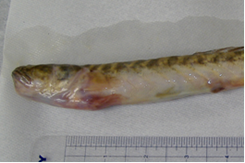
In late September of 2007, Event Response provided funds to the Dauphin Island Sea Lab, Alabama Department of Public Health, and University of Maryland to support sampling and toxin analysis during a highly toxic bloom of Karlodinium veneficum in the Weeks Bay (Alabama) National Estuarine Research Reserve System (NERRS) site. The Karlodinium bloom began in late June and was associated with five fish kills from June through late September, including one event in which several thousand Violet Gobies died. Toxin analysis confirmed karlotoxin in tissues of Violet Gobies. The Karlodinium bloom was then succeeded by a dense bloom of Kryptoperidinium folaceum that lasted through October. The Karlodinium bloom was consistently found where the Fish River and Weeks Bay converge, and initial results indicated higher nitrogen and phosphorus than observed in previous years. Sampling and analysis during these bloom events will be beneficial for discovering bloom causation and for formulating a management plan that protects the resources of the Weeks Bay NERRS site.
Investigating Extent and Impacts of Cochlodinium bloom in Chesapeake Bay and Tributaries
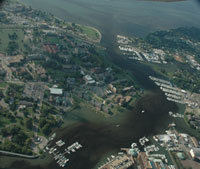
In September 2007, Event Response provided emergency funds to scientists at Old Dominion University, VA, and Stony Brook University, NY, to sample the extent and investigate fishery impacts of a bloom caused by the dinoflagellate Cochlodinium polykrikoides occurring in the Chesapeake Bay and some of its tributaries. The bloom, which likely originated in the Elizabeth River and then spread into other rivers and the Bay, was associated with fish kills and caused beach closures, extensive media coverage, and public alarm in Virginia. There was also concern that the bloom could interfere with on-going oyster spat planting activities in the region. Initial toxicity tests showed rapid larval fish mortality when exposed to bloom samples, and similar tests with oyster spat showed 20% mortality in 48 hours. The researchers coordinated with other responders throughout the region, such as those conducting aerial overflights of the bloom, to maximize sampling efficiency. These data aided mitigation of the event as it was occurring, and the knowledge gained will improve management capabilities for future events.
2006
Mitigating Impacts of Fish Killing Algal Bloom in Puget Sound, Washington
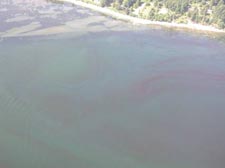
In August 2006, Event Response provided emergency funds to coordinate efforts for mitigating impacts of a fish killing bloom of the harmful alga, Heterosigma, in Puget Sound. In late June and early July 2006, major farmed fish losses occurred in Northern Puget Sound and Port Angeles Harbor due to a bloom that originated in Northern Puget Sound. In early August, a separate bloom threatened aquaculture, aquaria, and marine resources in the main body of Puget Sound. The Event Response funding allowed immediate coordination of sampling and information flow among a network of scientists, managers, and stakeholders (e.g. fish farmers), which was a critical need for management and mitigation of this harmful algal bloom, and for future events. Information gathered during this event will also be used to revise an existing conceptual model of bloom initiation and spread, in support of developing a predictive capability.
Monitoring in Casco Bay, Maine, during Alexandrium HAB Event
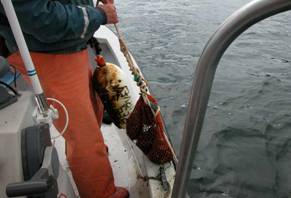
In June 2006, Event Response provided funding to the Maine Department of Marine Resources (DMR) to extend their Casco Bay buoy monitoring program, which augmented regular DMR sampling, for five additional weeks. As part of their monitoring program, Maine DMR, in partnership with Casco Bay Estuary Partnership, measured Alexandrium abundance and sampled toxin accumulation in sentinel mussel bags placed at the edges of shellfish resource areas. The Event Response funding allowed the fine-scale sampling to continue through the peak of the 2006 Alexandrium bloom. Overall, the novel monitoring program enabled managers to maintain over 11,000 acres open for soft-shell clam harvest that would have otherwise been closed. Managers used the successful demonstration of the fine-scale monitoring program to convince Maine leaders to allocate a portion of the 2005 HAB Federal Disaster Relief funds for sustainment and expansion of this monitoring effort through 2008 and into other bays. The project may also serve as a pilot for future large-scale inshore monitoring programs. Furthermore, the data will provide a critical link between inshore shellfish toxicity and local and offshore Alexandrium abundance that can be incorporated into models to predict shellfish toxicity.
Monitoring for Alexandrium in Gulf of Maine
CSCOR funding awarded in 2005 as follow-up to the 2005 bloom (see below) supported new maps of Alexandrium cyst seedbeds (which gave a preliminary indication of bloom potential in 2006) and supported research cruises for monitoring Alexandrium abundance and distribution in New England waters in Spring 2006. For more about the 2006 Alexandrium bloom and event response, click here.
2005
Karenia brevis, Low Oxygen, and Benthic Mortalities in Florida
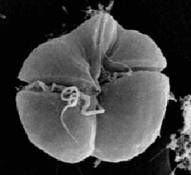
In August 2005, Event Response supported the State of Florida in mapping low oxygen and high Karenia brevis abundance to investigate the underlying cause of reported benthic mortalities. Researchers from Florida Fish and Wildlife Research Institute (FWRI) and the University of South Florida sampled surface and bottom water at 28 stations spanning from the mouth of Tampa Bay north to Pasco County. The cruise results, combined with ancillary data, suggested that a combination of factors associated with the Karenia bloom created an expansive low oxygen region that caused animal mortalities in an area of over 2,100 square miles of hardbottom communities and patch reefs. For more about this event...
Alexandrium fundyense Bloom in Massachusetts Bay and Expanded Efforts in New England
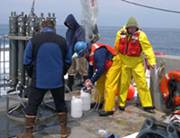
Event Response supported monitoring of the extent and movement of the largest Alexandrium bloom in New England in 30 years. This data helped to provide managers with early warnings of shellfish toxicity to protect public health in the region, and also allowed them to focus toxin sampling on areas where shellfish openings were most likely possible. This effort was critical to the NOAA response effort and led to continuous, high quality bloom predictions and tracking as the bloom expanded. For more about this event...
Harmful Algal Bloom Training in Oregon
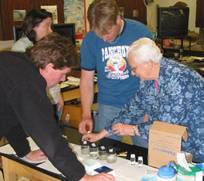
The highest levels of domoic acid in mussels ever observed in Oregon (more than eight times the safe limit) prompted Oregon health and shellfish managers to initiate an Oregon Harmful Algal Bloom Program based on the successful Olympic Region Harmful Algal Bloom (ORHAB) Project in Washington. Event Response funding sponsored a workshop in which 12 environmental and human-health officials from Oregon learned new techniques, such as phytoplankton cell counts and rapid toxin tests, which can provide early warnings for potential toxin-related shellfish bed and beach closures. For more about this event...
Reappearance of the Texas Brown Tide in Upper Laguna Madre, Texas
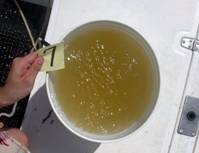
Event Response funding allowed researchers from the University of Texas at Austin Marine Science Institute (UTMSI) to rapidly sample the extent of Aureoumbra lagunensis (also known as Texas Brown Tide) when it reappeared in Laguna Madre. Past experience with Aureoumbra lagunensis in the Laguna Madre system suggested this bloom could persist for years, threatening its extensive seagrass meadows. UTMSI researchers were able to determine baseline information on physical and chemical parameters and cell concentrations at the onset of the bloom. Findings communicated to the Texas Parks and Wildlife Division (TPWD), helped the agency analyze potential risks to popular fisheries dependent upon healthy seagrasses in the highly productive system. For more about this event, see the UTMSI web page.
2004
Great Blue Heron Steatitis in Maryland

In fall of 2004, an abnormal number of great blue herons were diagnosed with steatitis (also called "yellow fat disease") in Maryland . The sick or dying birds were found in areas where cyanobacterial blooms were ongoing. Event Response provided funding to the U.S. Fish & Wildlife Service to support toxin analysis in tissue and water samples to determine if cyanobacterial toxins contributed to the development of steatitis in the affected great blue herons.
Cyanobacteria in Chesapeake Bay and the Potomac River
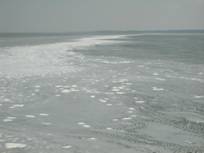
Event Response supported toxin analysis to allow Maryland Department of Natural Resources to assess toxin variability associated with an extensive, and taxonomically diverse, cyanobacterial bloom in the Potomac River in late summer of 2004. The cyanobacterial toxin, microcystin, was detected in all samples, with levels high enough to pose human health risks in some locations. The results also showed that anatoxin-a was present in some samples, indicating the potential for synergistic toxic effects. This new information was combined with historical data and used to educate the public regarding cyanobacterial blooms and associated health risks through media outlets and web reports.
Bottlenose Dolphin Mortality in Florida
Between March 10 and April 13, 2004, 107 bottlenose dolphins (Tursiops truncates) stranded dead along the Florida Panhandle; a considerably high number compared to an annual average of eight per year for the Panhandle. CSCOR HAB Event Response contributed to a broad NOAA response, by providing funding to Florida Marine Research Institute to support critical sampling for Karenia brevis cell counts, toxins, and other water quality information offshore and around St. Joseph Bay, where the majority of mortalities were localized. Brevetoxin measured in water and fish suggested that biotoxins were a likely cause of mortality. For more about this event, visit the NOAA Fisheries Service Office of Protected Resources web page.
2003
Cyanobacterial Toxicity in Upper San Francisco Bay
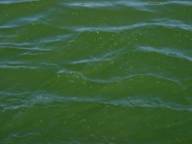
Event Response supported an assessment of toxicity related to a bloom of the cyanobacteria Microcystis aeruginosa in upper San Francisco Bay. Event Response assisted California Department of Water Resources (CA DWR) by identifying laboratory and analytical services for investigating bloom toxicity and by supplying funds for toxin analysis. The results were used to inform the public, stakeholders, and government resource managers and to guide future management action. This initial assessment of bloom toxicity has prompted further resources in the state to monitor the potential long-term impact of the bloom on human health and ecosystem function. For more about this event, see the Lehman et al. 2005 publication in Hydrobiologia: Distribution and toxicity of a new colonial Microcystis aeruginosa bloom in the San Francisco Bay, California.

